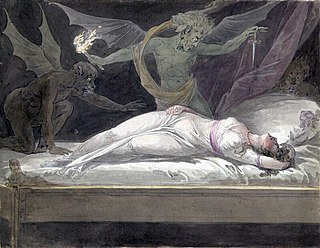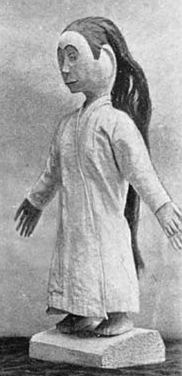Related Research Articles

Lilith, also spelt Lilit, Lilitu, or Lilis, is a female figure in Mesopotamian and Jewish mythology, theorized to be the first wife of Adam and supposedly the primordial she-demon. Lilith is cited as having been "banished" from the Garden of Eden for not complying with and obeying Adam.

In Mesopotamian mythology, Lamashtu was a female demon/monster/malevolent goddess or demigoddess who menaced women during childbirth and, if possible, kidnapped their children while they were breastfeeding. She would gnaw on their bones and suck their blood, and was charged with a number of other evil deeds. She was a daughter of the Sky God Anu.

In ancient Mesopotamian religion, Pazuzu is a personification of the southwestern wind, and held kingship over the lilu wind demons.

The púca, pucapwca, pooka, phouka, puck is a creature of Celtic, English, and Channel Islands folklore. Considered to be bringers both of good and bad fortune, they could help or hinder rural and marine communities. Púcaí can have dark or white fur or hair. The creatures were said to be shape-changers that could take the appearance of horses, goats, cats, dogs, and hares. They may also take a human form, which includes various animal features, such as ears or a tail.

An incubus is a demon in male form in folklore that seeks to have sexual intercourse with sleeping women; the corresponding spirit in female form is called a succubus. Parallels exist in many cultures.

An incantation, a spell, a charm, an enchantment, or a bewitchery, is a magical formula intended to trigger a magical effect on a person or objects. The formula can be spoken, sung, or chanted. An incantation can also be performed during ceremonial rituals or prayers. In the world of magic, wizards, witches, and fairies allegedly perform incantations.
Georgian mythology refers to the mythology of pre-Christian Georgians, an indigenous Caucasian ethnic group native to Georgia and the South Caucasus. The mythology of the Kartvelian peoples is believed by many scholars to have formed part of the religions of the kingdoms of Diauehi, Colchis and Iberia.
A shtriga is a vampiric witch in Albanian mythology and folklore that sucks the blood of infants at night while they sleep, and then turns into a flying insect. Only the shtriga herself could cure those she had drained. The shtriga is often pictured as a woman with a hateful stare and a horribly disfigured face. They usually live in hidden places in the forest and have supernatural powers. The term shtriga is used also with the common meaning of "witch", referring to a bad and ugly old woman who casts evil spells upon people. The male noun for shtriga is shtrigu or shtrigan.
Al or Hal is a class of demon in the folklore of the Caucasus, Iran, Central Asia, and Armenia. Als are demons of childbirth, interfering with human reproduction. The al is known by various other names, including alk in Armenian and Kurdish, ol, hāl and xāl in Tajikistan and Afghanistan, almasti or albasti in Central Asian Turkic-speaking countries, and halmasti among the Dards.

Brazilian mythology is the subset of Brazilian folklore with cultural elements of diverse origin found in Brazil, comprising folk tales, traditions, characters and beliefs regarding places, people, and entities. The category was originally restricted to indigenous elements, but has been extended to include:

Colombian folklore are beliefs, customs and cultural traditions in Colombia.
Mythic humanoids are legendary, folkloric, or mythological creatures that are part human, or that resemble humans through appearance or character. Each culture has different mythical creatures that come from many different origins, and many of these creatures are humanoids. They are often able to talk and in many stories they guide the hero on their journey.

Legends of vampires have existed for millennia; cultures such as the Mesopotamians, Hebrews, ancient Greeks, and Romans had tales of demonic entities and blood-drinking spirits which are considered precursors to modern vampires. Despite the occurrence of vampire-like creatures in these ancient civilizations, the folklore for the entity known today as the vampire originates almost exclusively from early 18th-century Southeastern Europe, particularly Transylvania as verbal traditions of many ethnic groups of the region were recorded and published. In most cases, vampires are revenants of evil beings, suicide victims, or witches, but can also be created by a malevolent spirit possessing a corpse or a living person being bitten by a vampire themselves. Belief in such legends became so rife that in some areas it caused mass hysteria and even public executions of people believed to be vampires.
Gello, in Greek mythology, is a female demon or revenant who threatens the reproductive cycle by causing infertility, miscarriage, and infant mortality. By the Byzantine era, the gelloudes (γελλούδες) were considered a class of beings. Women believed to be under demonic possession by gelloudes might stand trial or be subjected to exorcism.

In mythology and folklore, a vengeful ghost or vengeful spirit is said to be the spirit of a dead person who returns from the afterlife to seek revenge for a cruel, unnatural or unjust death. In certain cultures where funeral and burial or cremation ceremonies are important, such vengeful spirits may also be considered as unhappy ghosts of individuals who have not been given a proper funeral.

The langsuyar, also lang suir or langsuir, is a female revenant in Malay and other mythologies in the Malay archipelago. The word is derived from the Malay word for eagle (helang).

The night hag or old hag is the name given to a supernatural creature, commonly associated with the phenomenon of sleep paralysis. It is a phenomenon which a person feels during a presence of a supernatural malevolent being which immobilizes the person as if sitting on their chest or the foot of their bed. The word "night-mare" or "nightmare" was used to describe this phenomenon before the word received its modern, more general meaning. Various cultures have various names for this phenomenon and supernatural character.
In Slavic mythology, bolotnik, balotnik, bolotyanik or błotnik is a male swamp spirit. There are many descriptions of bolotnik. Usually he was portrayed as a man or an old man who has big, frog-like eyes, a green beard and long hair. His body is covered with dirt, algae and fish scales. The legends from the Vitebsk Governorate of Russia said that bolotnik is a dirty, fat, eyeless creature that motionlessly sits at the bottom of the swamp. In some accounts bolotnik is also said to have long arms and a tail. Just like the majority of Slavic water spirits, he would lure and drag people into the water if they get close to the edge. It is believed that bolotnik has neither wife nor children; in the other legends he is married to bolotnitsa, a female swamp spirit.
References
- 1 2 3 4 Geller, Florentina Badalanova (2015-11-13). Johnson, J. Cale (ed.). In the Wake of the Compendia: Infrastructural Contexts and the Licensing of Empiricism in Ancient and Medieval Mesopotamia. Walter de Gruyter GmbH & Co KG. p. 179. ISBN 978-1-5015-0250-7.
- ↑ Gaster, M. (1900). "Two Thousand Years of a Charm against the Child-Stealing Witch". Folklore. 11 (2): 129–162. doi:10.1080/0015587X.1900.9720525. ISSN 0015-587X. JSTOR 1253249.
- ↑ "Mythology and Music Bring Dark Tale to Life in SAMCA | Beyond James". 2022-07-07. Retrieved 2023-12-27.